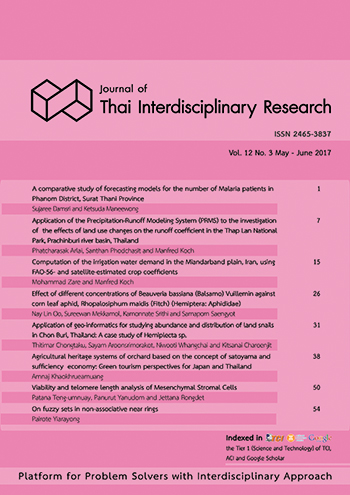Agricultural heritage systems of orchard based on the concept of satoyama and sufficiency economy: Green tourism perspectives for Japan and Thailand
Main Article Content
Abstract
This paper finds out the similarities and differences of the orchard systems underpinning the concepts of Japan’s satoyama and Thailand’s Sufficiency Economy Agriculture (SEA), to understand the distinctive features that correspond to the five criteria of the Globally Important Agricultural Heritage Systems (GIAHS) designation. Also, it presents green tourism perspectives in both the systems. In the study, a data analysis was conducted of the secondary resources and field surveys concerning the GIAHS Minabe-Tanabe Ume (Japanese apricot) system area of the Wakayama prefecture and the longan (lamyai) cultivation area in the Chom Cheang village of Chiang Mai Province. The similarities reveal five aspects of all criteria. Firstly, both systems have supported livelihoods and food security through the fruit industry and other diversified agricultural products. Secondly, they have given rise to high biodiversity that has been nurtured and maintained by forests, mixed orchards, and irrigation systems. Thirdly, the systems have adopted wisdom, knowledge, and technologies in developing the diverse genetic resources and nurturing excellent varieties of fruit. Fourthly, the orchards of both sites were dependent on the rice culture. Lastly, the remarkable landscape consisted of forests, orchards, sacred sites, mixed crops, and rice fields. As a result, the lamyai system based on the concept of SEA was acceptable with regard to all of the GIAHS criteria, when compared with the ume system based on the satoyama landscape. However, there were differences in using sources of wood for fuel, the irrigation systems, the methods of forest conservation, the ume and lamyai cuisines in the dietary culture, and the attractiveness of seasonal changes in orchard scenery. Green tourism espouses four perspectives for sustaining the GIAHS sites; these perspectives form a basis for guidelines for cooperation between Japan and Thailand. These guidelines concern promoting farm products for inbound tourists, conserving biodiversity, passing on the traditional techniques and agriculture, linking the sites of GIAHS with the UNESCO World Heritage program to increase tourism demand and accelerating the gentrification process in rural communities.
Article Details
How to Cite
Khaokhrueamuang, A. (2017). Agricultural heritage systems of orchard based on the concept of satoyama and sufficiency economy: Green tourism perspectives for Japan and Thailand. Interdisciplinary Research Review, 12(3), 38–49. https://doi.org/10.14456/jtir.2017.19
Section
Research Articles


